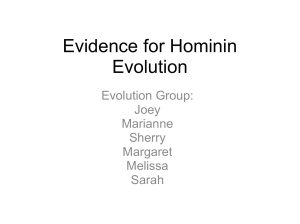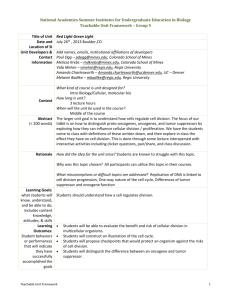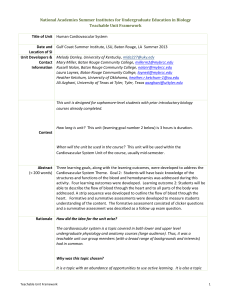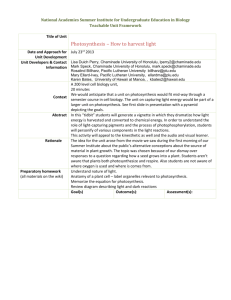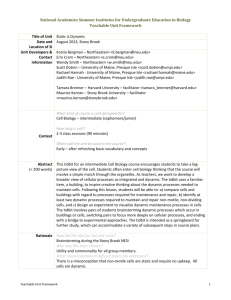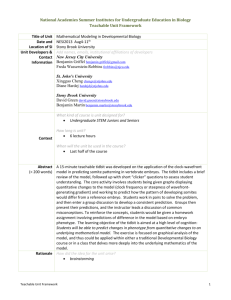Gene Expression Basic Overview (framework) Northeast 2013
advertisement
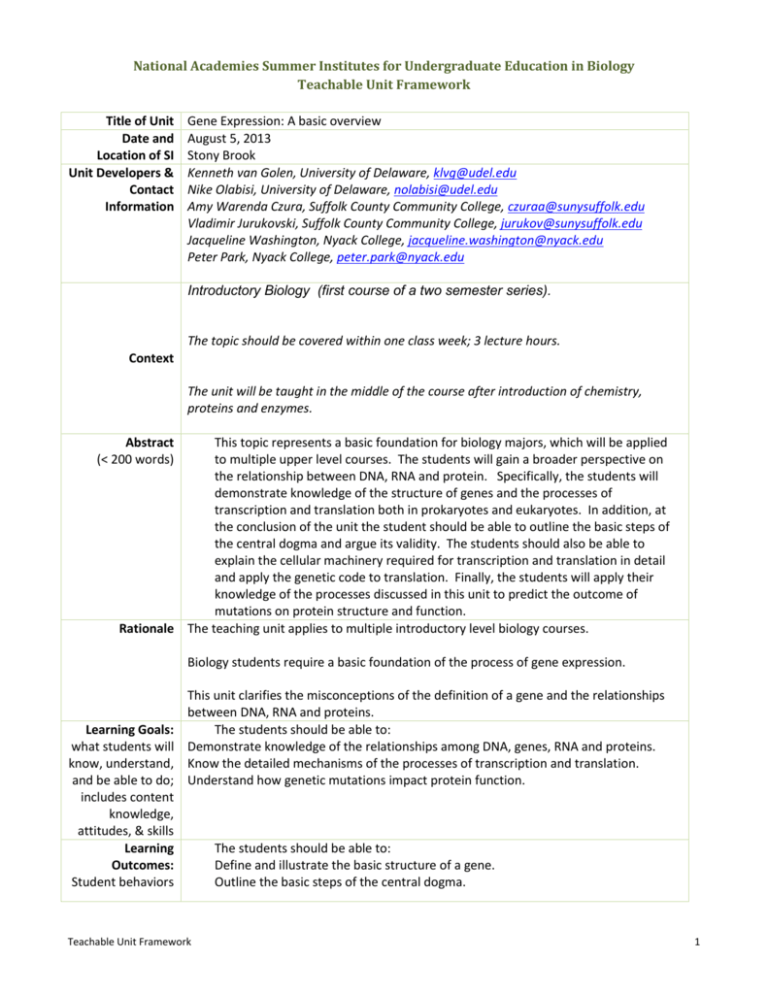
National Academies Summer Institutes for Undergraduate Education in Biology Teachable Unit Framework Title of Unit Date and Location of SI Unit Developers & Contact Information Gene Expression: A basic overview August 5, 2013 Stony Brook Kenneth van Golen, University of Delaware, klvg@udel.edu Nike Olabisi, University of Delaware, nolabisi@udel.edu Amy Warenda Czura, Suffolk County Community College, czuraa@sunysuffolk.edu Vladimir Jurukovski, Suffolk County Community College, jurukov@sunysuffolk.edu Jacqueline Washington, Nyack College, jacqueline.washington@nyack.edu Peter Park, Nyack College, peter.park@nyack.edu Introductory Biology (first course of a two semester series). The topic should be covered within one class week; 3 lecture hours. Context The unit will be taught in the middle of the course after introduction of chemistry, proteins and enzymes. Abstract (< 200 words) This topic represents a basic foundation for biology majors, which will be applied to multiple upper level courses. The students will gain a broader perspective on the relationship between DNA, RNA and protein. Specifically, the students will demonstrate knowledge of the structure of genes and the processes of transcription and translation both in prokaryotes and eukaryotes. In addition, at the conclusion of the unit the student should be able to outline the basic steps of the central dogma and argue its validity. The students should also be able to explain the cellular machinery required for transcription and translation in detail and apply the genetic code to translation. Finally, the students will apply their knowledge of the processes discussed in this unit to predict the outcome of mutations on protein structure and function. Rationale The teaching unit applies to multiple introductory level biology courses. Biology students require a basic foundation of the process of gene expression. Learning Goals: what students will know, understand, and be able to do; includes content knowledge, attitudes, & skills Learning Outcomes: Student behaviors This unit clarifies the misconceptions of the definition of a gene and the relationships between DNA, RNA and proteins. The students should be able to: Demonstrate knowledge of the relationships among DNA, genes, RNA and proteins. Know the detailed mechanisms of the processes of transcription and translation. Understand how genetic mutations impact protein function. Teachable Unit Framework The students should be able to: Define and illustrate the basic structure of a gene. Outline the basic steps of the central dogma. 1 National Academies Summer Institutes for Undergraduate Education in Biology Teachable Unit Framework or performances that will indicate they have successfully accomplished the goals Define and explain the process of transcription. Compare and contrast prokaryotic and eukaryotic transcription. Apply genetic code to translation. Define and explain the process of translation. Discuss the strengths and weaknesses of the central dogma and argue its validity. Describe the various types of genetic mutations. Predict the effect of mutations on protein structure and function. Incorporation of Scientific Teaching Themes Active Learning How students will engage actively in learning the concepts Assessment How teachers will measure learning; how students will selfevaluate learning Activities outside of class: Homework with high Blooms level questions. Homework would extend the activities performed in class. Pre-assessments: Activities in class: Post-tidbit assessments: Clicker and writing assignments, homework. Clicker, Think-pair-share, writing assignments, class interaction and discussion. Clicker, quizzes and writing assignment Diversity (Inclusion) How the unit is designed to include participants with a variety of experiences, abilities, and characteristics Inclusion of multiple learning activities to accommodate students with different backgrounds, learning styles and personalities. Activities during tidbit: Clickers, group discussion, writing assignment, worksheet, puzzle solving and question/answer. Reverse the activity-given amino acid sequence student will need to Teachable Unit Framework 2 National Academies Summer Institutes for Undergraduate Education in Biology Teachable Unit Framework work backwards and determine DNA sequence. Sample Presentation Plan (general schedule with approximate timing for unit) Session 1 Time (min) Learning Outcome(s) Preclass Understanding details 2 hours of transcription, translation, central dogma and genetic code. Activity/assessment Clicker, quiz Explanation, notes, suggestions, tips The students will be able to answer higher Bloom level questions about the central dogma by outlining the strengths and weakness of the central dogma, specifically giving exceptions to the rule. Enter approx. class time for learning activity preparatory material presentation Teachable Unit Framework 3 National Academies Summer Institutes for Undergraduate Education in Biology Teachable Unit Framework 20 minutes Enter approx. class time for learning activity #1 20 min Enter approximate time for additional learning activities and associated class Work/preparatory materials 15 minutes Describe the various types of genetic mutations. Predict the effect of mutations on protein structure and function. Develop rubric for homework assignment. Clicker questions, writing assignment, Think-PairShare, Group discussion, homework, Reverse the activity-given amino acid sequence student will need to work backwards and determine possible DNA sequence. Structure of amino acids and the consequence of amino acid substitutions with varying biochemical and structural properties. The degenerative nature of the genetic code can also be included. Consider varying clicker activity by starting with coding (instead of template) strand of DNA. The homework will be extended by having the students determine what the frequency of mutation in the human genome and which base position is more frequently altered. Enter approximate time for post-activity summing up or transition 5 minutes Teachable Unit Framework 4 National Academies Summer Institutes for Undergraduate Education in Biology Teachable Unit Framework Add additional activities information as needed for the unit. Resources for Teaching the Unit Clickers, handouts and worksheets, genetics concepts inventory and misconception of concepts. Bowling BV, Acra EE, Wang L, Myers MF, Dean GE, Markle GC, Moskalik CL, Huether CA. 2008. Innovations in teaching and learning genetics: Development and evaluation of a genetics literacy assessment instrument for undergraduates. Genetics 178,15-22. Smith MK, Wood WB, Knight JK. 2008. The genetics concept assessment: A new concept inventory for gauging student understanding of genetics. The American Society for Cell Biology 7, 422-430. Bibliography – STCSE (Students' and Teachers' Conceptions and Science Education); compiled by Reinders Duit: http://www.ipn.uni-kiel.de/aktuell/stcse/ Effectiveness of unit (if you have used it in your own teaching) Acknowledgements Ross Nehm and Casey Roehrig Teachable Unit Framework 5

